Discovering the Depths of Geodes and Agates
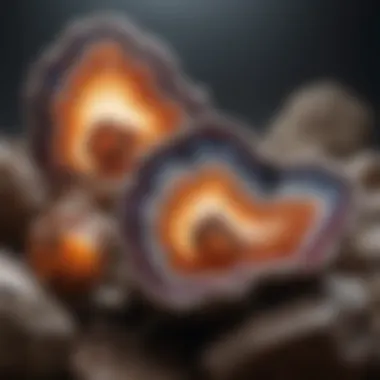
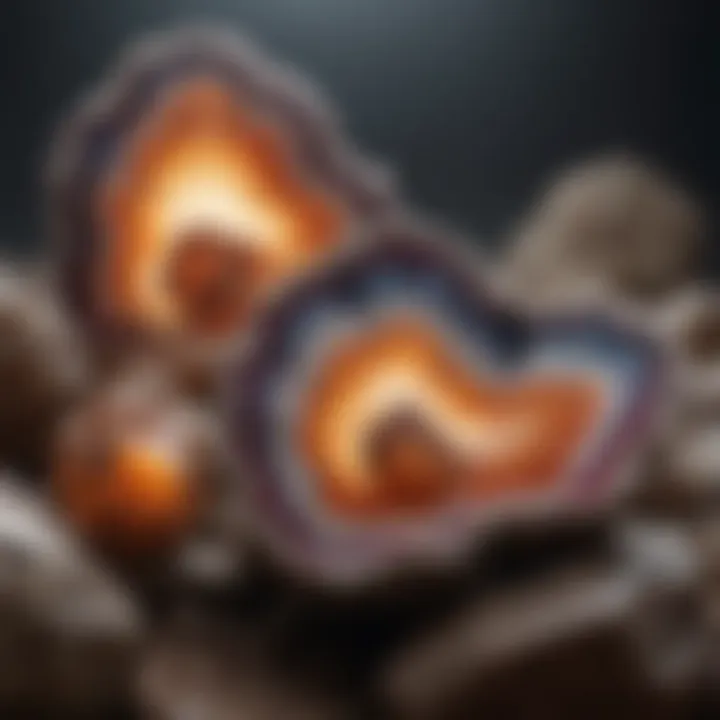
Intro
Geodes and agates, two extraordinary wonders of nature, have a way of stirring curiosity and admiration among collectors and enthusiasts. Found in various locations across the globe, these geological marvels hold fascinating stories within their crystalline interiors. Whether you’re an experienced collector or someone just starting out, understanding these formations is crucial. From their formation, types, to care tips, this article will peel back the layers and provide a rich yet clear view into the world of geodes and agates.
Collecting these specimens is not just about ownership; it’s about grasping the science, history, and artistry behind each piece. With every jagged edge and polished surface, there lies a history waiting to be discovered. As we embark on this journey, let's first delve into our featured collectible of the month.
Featured Collectible of the Month
Overview
This month, we’re shining a spotlight on the stunning amethyst geode. Renowned for its striking purple hues, the amethyst geode is a must-have for any collector. Its unique hexagonal formations create an inviting display that many enthusiasts cherish. The amethyst crystals, which are a type of quartz, not only catch the eye but also invite deeper appreciation for their natural formation process. Amethyst geodes have often been seen as symbols of peace and tranquility, making them desirable not just for their aesthetic but also for the energy they are believed to emanate.
Historical Significance
The history of amethyst is rich and varied. In ancient times, it was considered a precious stone, often worn by royalty or used in ceremonial artifacts. The Greeks believed that amethyst could prevent intoxication, which is how it got its name—derived from the Greek word ‘amethystos’ meaning ‘not intoxicated’. Cultures across time have valued this stone, creating a narrative that intertwines with its natural beauty.
With its longstanding significance, amethyst geodes continue to fascinate modern collectors, serving as reminders of our planet's incredible geological processes.
Identification Techniques
When out hunting for geodes and agates, knowing how to identify these specimens can save collectors both time and money. Not all stones hold hidden treasures, so expertise in identification is essential.
Visual Characteristics
- Color: Agates display a spectrum of colors, often banded with contrasting hues. Look for vibrant bands, usually within the stone itself.
- Surface Texture: Geodes have rough outer shells that can be jagged or smooth. Once cracked open, one can find a hollow cavity usually lined with crystal formations.
- Weight: Many newbies forget that heft can be a hint; a true geode might feel heavier than it looks due to its internal structure.
Resources for Identification
Navigating the world of minerals takes practice and research. Here are some helpful resources:
- Wikipedia on Geodes
- Britannica: Agates
- Forums on Reddit where enthusiasts share insights and advice.
Remember, practice makes perfect. The more you learn and observe, the sharper your identification skills will become.
"Nature is but a canvas to our imagination—what lies beneath can often tell a greater story than what meets the eye."
As we venture deeper into this article, we’ll further explore the formation processes, different types of geodes and agates, and tips that can help collectors effectively maintain their collections. This is just the beginning of a fascinating exploration into these geological masterpieces.
Prolusion to Geodes and Agates
Geodes and agates hold a special place in the hearts of collectors and enthusiasts alike. Their natural beauty and intricate formation processes make them fascinating subjects of study. To grasp the full scope of these geological wonders, one must first understand their definitions and distinctions. This section serves as a vital foundation for the subsequent exploration of their formation, characteristics, and significance. By grasping the concept of geodes and agates, readers gain insights into their physical properties and the processes that create them.
Defining Geodes
At their core, geodes are hollow, spherical formations within rocks that are lined with mineral crystals. Picture a nondescript ball of stone, its unassuming exterior hiding a stunning array of colors and shapes. Some geodes are small enough to fit in the palm of your hand, while others can reach sizes as large as a watermelon. To define a geode is to delve deeper than its exterior — the true beauty lies within.
When talking about geodes, it’s important to mention their often rough and rocky exteriors, which might mislead a casual observer into thinking there’s nothing of interest. However, once they are cracked or cut open, the brilliance of the crystals inside becomes apparent. The most common minerals present in geodes include quartz, amethyst, and calcite. Their formation is closely linked to volcanic and sedimentary processes.
Understanding Agates
Agates, on the other hand, are a type of chalcedony and are characterized by their striking bands and patterns. They can exhibit a rich spectrum of colors and textures, born from variations in mineral content during their formation process. Unlike geodes, agates aren’t typically hollow. Instead, they present a dense, solid body containing a complex interplay of hues and layers.
Think of agates as nature's artwork — each stone tells its own unique story through its appearance. The bands, which can range from thin and delicate to wide and bold, often result from the layering of mineral deposits, leading to a visual effect that enchants many collectors. Agates can come in various varieties, such as moss agate, with patterns reminiscent of trees, or lace agate, showcasing delicate floral designs. Not only are these stones stunning, but they also have an interesting backdrop of folklore and symbolism, often associated with stability and grounding.
"When you look at a geode or an agate, you're not just seeing a stone; you're looking at a piece of history. They encapsulate the dynamic processes of our planet in their very essence."
In summary, the distinction between geodes and agates is critical. Grasping these definitions sets the stage for exploring their formation, distinctive features, and the roles they play in both nature and collectors' collections. Understanding them not only enhances one's appreciation but also inspires deeper exploration into the geological marvels they embody.
Geological Formation Processes
Understanding geological formation processes is fundamental when exploring geodes and agates. This section sheds light on how these natural wonders come into existence, emphasizing their connection to various geological phenomena. Analyzing these processes helps uncover the rich tapestry of history embedded in each geode and agate, illustrating not just the beauty but the complexity of the Earth’s crust.
How Geodes Form
Geodes are fascinating structures that form through distinct processes related to volcanic activity and mineral alteration. Each aspect contributes to the overall understanding of geodes and the environments in which they develop.
The Role of Volcanic Activity
Volcanic activity plays a pivotal role in the formation of geodes. When a volcano erupts, it ejects ash and gases that can create voids in the surrounding rock. These cavities eventually become ideal places for mineral deposits to form. The key characteristic of volcanic activity is its ability to produce the conditions necessary for gases to expand and create spaces within solidified rock. This is a beneficial aspect as it leads to the development of geodes that can host beautiful crystals.
One unique feature of this process is that the type of volcanic rock can influence the mineral composition of the geode. For example, basalt is known to host some of the most stunning quartz and amethyst geodes. One disadvantage, however, is that not all volcanic environments produce geodes; thus, location can be critical to finding them.
Mineral Infusion
Mineral infusion involves the introduction of various minerals into the voids of geodes over time. As water containing dissolved minerals seeps through porous rock, it deposits these minerals in the cavity, leading to crystallization. This process is fascinating because it highlights the interconnection between water and minerals in geological formations. Mineral infusion is popular to explore as it provides insight into the mineral variety present in geodes.
The unique aspect of mineral infusion is that it can lead to vibrant color variations in the crystals that form, depending on the minerals present. However, if the mineral sources are limited, the resulting geodes may be less colorful and visually striking.
Hydrothermal Processes
Hydrothermal processes occur when heated water circulates through rocks, often associated with volcanic regions. This warming can dissolve minerals from surrounding structures and subsequently deposit them into geodes. The critical characteristic of hydrothermal processes is their ability to introduce outstanding minerals such as quartz, calcite, and even rare ones like fluorite.
Benefit-wise, these processes can create geodes with exceptional crystal formations and clarity, making them popular among collectors. However, these processes can also be unpredictable, depending on geological pressures and temperatures, which could yield geodes of varying quality.
Agate Formation Details
Agates, celebrated for their banded patterns and rich coloration, have their own formation intricacies that deserve attention.
Layering Process
The layering process is a defining feature of agate formation. It occurs when mineral-rich waters flow into a cavity and deposit minerals in layers over extended periods. One key characteristic of this process is the slow accumulation of materials, which leads to distinct bands in the final product.
Layering is significant because it results in the trademark agate bands that are sought after by collectors. However, the challenge lies in finding agates with well-defined bands, as many can appear more chaotic and less distinct.
Mineral Content Variation
Mineral content variation refers to the differences in minerals deposited during the agate formation process. Different conditions can lead to rich varieties of colors and patterns that make each agate unique. The key aspect here is how environmental factors, like the mineral content in water, can lead to diverse visual representations in agates.
This variation allows for a broad exploration of agates, making them appealing to hobbyists and serious collectors alike. But, erratic changes in mineral content can also result in less desirable agate formations.
Environmental Conditions
The environmental conditions under which agates form can significantly impact their appearance and quality. Factors like temperature, moisture, and pressure play a vital role in how minerals crystallize. The notable aspect of these conditions is that they can limit the growth rate of crystals, influencing the final look of the agate.
Agates formed in optimal conditions exhibit vibrant colors and clear banding, making them highly sought after. However, less-than-ideal conditions could lead to agates with muted colors or irregular patterns.
In summary, the geological formation processes of geodes and agates are integral to understanding these fascinating natural formations. From volcanic activity to the minute variations of mineral content, each aspect contributes to the diverse beauty these geological wonders present.
Distinct Characteristics of Geodes
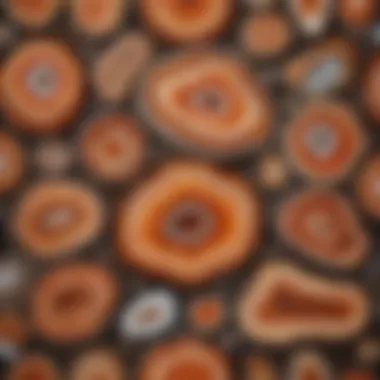
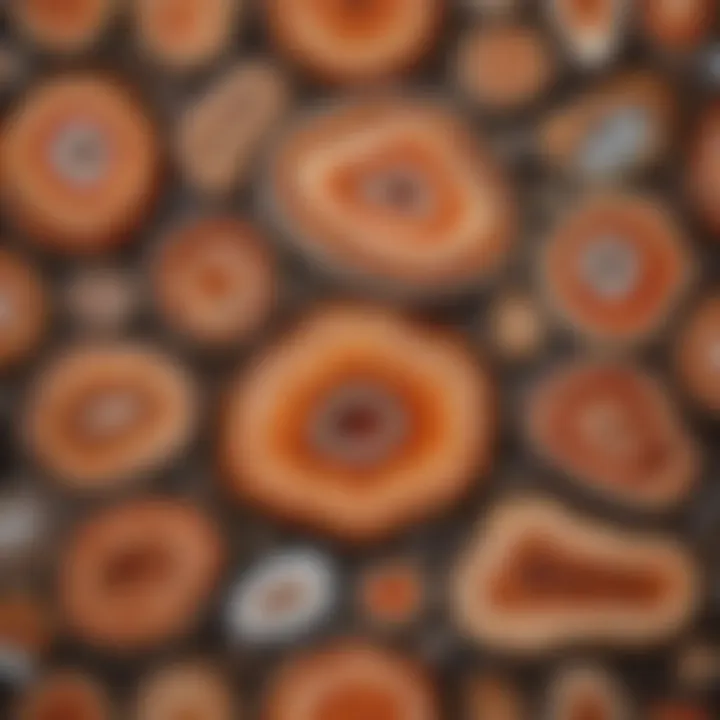
The distinct characteristics of geodes are crucial. They not only contribute to the beauty and uniqueness of each specimen, but also offer insight into the geological processes that shaped them. Understanding these traits is essential for collectors and enthusiasts. It helps guide decisions on what to acquire or appreciate. The textures, sizes, and colors of geodes can influence their value, desirability, and how they fit into a collection.
Exterior Properties
Surface Texture
The surface texture of geodes plays a significant role in their overall appeal. Commonly, geodes have a rough, rugged exterior that disguises the beauty hidden inside. This ruggedness often adds to their allure, as collectors appreciate the contrast between the outside and the glittering crystals within.
One key characteristic is the presence of small pits and ridges on the surface. These features provide a more organic look, which can make the geodes seem more part of nature compared to perfectly polished gemstones. For this article, this texture is deemed beneficial because it gives each piece a uniqueness that is hard to replicate. When examining surface textures, one might notice that some geodes have a more glassy feel due to certain minerals. However, this could be a double-edged sword; shiny surfaces might attract fingerprints and show wear over time.
Size Variability
Size variability in geodes is another fascinating aspect to explore. They can range from tiny specimens that fit in the palm of your hand to large, impressive pieces that require space and care. The dimensions of a geode greatly influence its value and collectibility. Larger geodes are often seen as more impressive and valuable due to their rarity and the sheer amount of material involved.
Collectors often seek out specific sizes for their displays. The size variability allows for a variety of showcasing methods, from small decorative pieces to large center displays in homes or museums. However, larger geodes can also present problems; they're heftier to transport and require greater care. Choosing the right size, therefore, is critical and might be determined by the collector's available space and personal taste.
Color Range
Color range is one of the most intriguing features of geodes. The hues can vary widely, offering everything from soft pastel shades to vibrant colors. This variance is often due to the different minerals that contribute to their formation. For instance, iron oxides can produce reddish hues, while manganese can create purples.
The appeal of a diverse color range cannot be overstated. It allows collectors to curate unique collections based on color themes or even seasonal preferences. The unique feature about colors in geodes is that they may change if light hits them at different angles. This optical effect often leaves viewers curious and enchanted, appealing to both collectors and casual observers alike. However, one must consider that not all colors in geodes appear vivid. Sometimes, the colors can look washed out if the mineral content is low or weathering occurs, which can detract from their appeal.
Interior Features
The interior features of a geode tell a deeper story of its formation and mineral composition. Exploring these can help collectors make informed choices when acquiring geodes.
Crystal Growth Patterns
Crystal growth patterns are a hallmark of geodes and can vary tremendously. They often resonate with collectors who value the intricate designs created by minerals over time. Patterns can include perfect geometric shapes or wild, chaotic formations, both of which can hold aesthetic appeal.
A key characteristic is symmetry, seen in perfectly formed quartz crystals that can cluster in a way that resembles a miniature forest. This symmetry often draws in collectors. The allure of these patterns lies in their uniqueness; no two geodes would have the same interior. However, one can note that awkward or irregular growth may indicate less desirable qualities in the specimen, such as unstable conditions during formation.
Common Minerals Found
Common minerals found within geodes include quartz, calcite, and various types of agate. The selection of minerals can affect a geode's value and desirability. Therefore, when evaluating a geode, it's essential to recognize these common minerals along with their rarer counterparts.
For this article, the presence of quartz makes for a popular choice. Quartz's clarity allows for light to play beautifully through the crystal formations, enhancing their visual interest. However, weak or poorly developed minerals can detract from the overall aesthetic. This is why this aspect is critical in the insight for rock and fossil collectors.
Rarity Factors
Finally, rarity factors come into play when discussing geodes. The rarity not only includes the type of minerals found, but also the geographical region from which the geode originates. Some regions are known for producing extraordinary specimens, while others may yield more common finds.
Moreover, colors or patterns that are less frequently seen often fetch higher prices. Collectors aiming to invest in rare geological specimens will look closely at these rarity factors.
One unique feature here is that the market for geodes can be volatile. Fluctuating demand can sometimes lead to dramatic increases or decreases in value. Hence, understanding the rarity and market trends is beneficial but also requires caution.
Agates: A Closer Look
The examination of agates provides valuable insights into their nature, appearance, and appeal among collectors. These beautiful minerals exhibit a variety of colors, patterns, and textures that make them intriguing. Understanding the nuances of agates not only enhances appreciation but also guides collectors in making informed decisions. The exploration of agates reveals how these elements come together in unique ways, solidifying their importance in the realm of geology and art.
Color Variations in Agates
Natural Color Producing Processes
The vibrant colors seen in agates originate from several natural processes. Agate formation involves the deposition of silica in layers, where minerals can infuse, altering their hues. This process ensures that each piece can have a distinct character. The key characteristic of this coloring is its naturality, which resonates well with collectors who advocate for authenticity. A major advantage of understanding these processes is that it highlights the geological history embedded in each agate piece. The downside, however, is that this natural variance can make some agates less uniform in appearance, appealing to certain collectors while perhaps deterring others.
Influence of Impurities
The impurities present in agate can greatly influence its final appearance. These foreign materials infiltrate during the formation, leading to an array of colors and patterns. Certain impurities, like iron or manganese oxides, can introduce vibrant reds and yellows, making the agate particularly sought-after. This blending of elements is beneficial within the context of personalizing a collection, as the uniqueness brings character to each specimen. On the flip side, some collectors may prefer pristine examples, viewing impurities as flaws rather than features.
Popular Color Types
Agates come in a spectrum of beloved color types, which play a crucial role in their desirability. Some of the much-coveted varieties include banded agate, which showcases multiple layers of color, striking fire agate with its fiery hues, and moss agate that features natural greenery across its surface. The appeal of these popular color types lies in their distinct artistic expression, inviting collectors to curate pieces that resonate with their personal aesthetic. However, the abundance of choices can sometimes lead to decision fatigue for novice collectors trying to navigate the vibrant marketplace.
Textural Distinctions
Banded Agates
Banded agates stand out for their layered look, often resembling the pages of a geological book. Each band may indicate different phases of mineral accumulation. This key characteristic helps define one's collection by showcasing geological history and creating visual interest. These layers allow for a myriad of color combinations that captivate onlookers. A downside, though, is their commonality in collections, possibly making them less distinctive depending on the abundance in one’s portfolio.
Dendritic Patterns
Dendritic patterns in agates offer a unique visual narrative with their branch-like formations. These patterns are often seen as natural artwork, enchanting those who appreciate the finer points of nature. The key aspect here is the aesthetic appeal of dendrites, which can imitate plants or trees, adding a layer of intrigue for the collector. Their rarity can also enhance their value, although the complexity of identifying genuine dendritic patterns can pose challenges for the untrained eye.
Flame Agate Features
Flame agates are truly one-of-a-kind for their captivating, fiery appearance, which evokes imagery of embers glowing. This unique feature is a result of internal reflections that create stunning optical effects. The allure of flame agates is significant, enchanting both new and seasoned collectors alike. However, the specific conditions required for their formation mean that they are less commonly found than other varieties, potentially driving prices upward.
"Each agate tells a story, not just of its own formation, but also of the Earth from which it came, serving as a tangible connection to the planet's geological history."
Categorizing Geodes
Categorizing geodes plays a vital role in understanding these fascinating formations. By classifying geodes into different types and regions, collectors can narrow down their search. They can better appreciate the diversity of forms and features found in geodes. This knowledge also aids in determining their value and rarity, which is particularly important for serious collectors.
Types of Geodes
Geodes can be broadly classified based on their mineral content and appearance. Understanding these types helps enthusiasts identify what they have and allows them to make informed collecting decisions.
Quartz Geodes
Quartz geodes are perhaps the most well-known type among collectors. Their appeal stems from the crystalline structures inside, often sparkly and mesmerizing.
Key characteristic: One distinctive aspect of quartz geodes is the uniform quartz crystals that line the interior. They are valued for their clarity and brilliance.
Quartz geodes present both benefits and disadvantages. On the positive side, they are widely available, making them more accessible for beginners. However, because they are common, collectors need to be discerning about the quality and unique features they seek. The sheer variety means that while some might be abundant, exceptional pieces can still fetch significant prices.
Amethyst Geodes
Amethyst geodes captivate many with their rich, purple hues and are often thought to carry special properties, particularly in the realm of healing and wellness.
Key characteristic: The signature purple of amethyst ranges from a light lilac to a deep violet, making these geodes particularly eye-catching.
Amethyst geodes are popular not just for their beauty but also for their significance in the metaphysical community. They are seen by many as offering calming energies and are often used in meditation practices. However, their popularity can lead to higher prices, meaning collectors have to weigh budget against desire strongly.
Calcite Geodes
Calcite geodes stand out due to their unique formations and properties. They often have stunning geometrical patterns that can be quite intricate.
Key characteristic: One intriguing feature of calcite geodes is their ability to fluoresce under ultraviolet light, revealing hidden colors and patterns.


While calcite geodes can be a delight for collectors, they can also require special care because they may be more susceptible to scratches compared to other compounds like quartz. On the upside, finding a well-preserved calcite geode can be truly rewarding for anyone looking to enhance their collection.
Regional Variations
Geodes can also be classified based on their geographical origins. This classification can lend insights into the geological history of the area where they are found, adding an extra layer of interest for collectors.
North American Geodes
North America is home to several renowned geode sites. Geodes from places like the Great Plains often yield surprises with their variety.
Key characteristic: A common feature is their relatively easy access, making them appealing for both new and experienced collectors.
The landscape contributes to the diversity in the types of minerals found within these geodes, presenting opportunities for collectors to discover unique pieces without having to travel far.
Brazilian Geodes
Brazil is famous for its rich deposits of geodes. Often home to some of the world’s most stunning amethyst and quartz geodes, the country is a prime destination for collectors.
Key characteristic: The abundance of high-quality specimens makes Brazilian geodes highly sought after.
However, the larger market can also mean increased competition and potentially inflated prices. Collectors may need to operate with a keen eye and perhaps develop connections with reputable dealers to secure the best finds.
European Geodes
Areas in Europe, particularly France and Germany, have their unique geological attributes that influence the types of geodes available.
Key characteristic: European geodes may feature lesser-known mineral types, which can add fascinating depth to a collection.
The historical context of geode collecting in Europe can enrich the experience, connecting collectors to a deeper narrative as they explore their finds. However, the rarity of certain types may come at a price, so collectors must balance their passions with practicality.
Diversity in Agate Types
Agates present a remarkable versatility that speaks to the heart of geological aesthetics. This diversity in agate types not only enhances their appeal among collectors but also augments the knowledge and appreciation of these geological wonders. Understanding the various types helps collectors differentiate between them, refine their collecting strategies, and appreciate the nuanced beauty each variant presents.
The fascination with agates springs from their variety in colors, patterns, and geological formations. Each type embodies a different aspect of nature's artistry, showcasing layers that tell a million-year-old story. This diverse range allows for an exploration of the geological processes that yield different agates, adding depth to the collective knowledge of enthusiasts.
Agates can be broadly categorized into common varieties, which many collectors encounter, and rare variants, which are highly sought after. Each category not only represents different visual characteristics but also varies in pricing and availability. Collectors should carefully consider their preferences, as both common and rare types can offer unique insights into Earth's history.
Common Agate Types
Moss Agate
Moss Agate isn’t actually a true agate but rather a variety of chalcedony, displaying moss-like inclusions within the stone. This feature gives it a distinctive appearance, resembling lush landscapes trapped in stone. Known for its earthy shades of green, brown, and white, it's a go-to choice for those who appreciate natural motifs. Its affordability makes it popular among beginners and seasoned collectors alike.
A unique aspect of Moss Agate is its grounding properties, often associated with stability and wellness. Collectors frequently value it not just for aesthetic appeal but also for its metaphysical attributes. While some find it lacks the vibrant colors typical of classic agates, many appreciate its subtlety and organic beauty.
Crazy Lace Agate
Crazy Lace Agate is a vibrant, colorful stone characterized by swirling patterns that delight the eyes. With a range of colors from yellows to peachy pinks and reds, this agate radiates warmth and enthusiasm. It is often referred to as the "happy" agate due to its lively appearance and energetic vibes.
The distinctive patterns swirl in chaos yet somehow combine harmoniously, making each gemstone truly one-of-a-kind. Its vibrant aesthetic often attracts attention, and it's commonly used in jewelry and decorative crafts, providing a timeless elegance to any piece. However, sourcing authentic Crazy Lace Agate can sometimes be a challenge, as the name has become a catch-all for similarly patterned stones.
Petrified Wood Agate
Petrified Wood Agate tells the story of ancient trees turned to stone, preserving their textures in a way that resonates with history enthusiasts. With its rich, earthy tones and fascinating, visible grain, it appeals to collectors fascinated by the intersection of nature and time. Each piece carries a narrative of its past, inviting introspection and reflection.
The unique beauty of Petrified Wood Agate lies in its organic patterns alongside the stability and durability of agate. This makes it a practical choice for various uses, from artistic sculptures to jewelry. However, collectors should be mindful of the sourcing practices, as authentic specimens can sometimes be mislabelled or commodified in ways that obscure their origin.
Rare Agate Variants
Fire Agate
Fire Agate is a stunning variant that displays an iridescent sheen, caused by a thin layer of iron oxide within the stone. This shimmering quality encapsulates the essence of fire and passion, making it an alluring choice for those in search of dramatic flair in their collection. Its play of light can captivate even the most discerning enthusiast.
With notable difficulty in cutting and polishing, Fire Agate can often be more expensive than its more common counterparts. While its vibrant visual impact is unparalleled, care must be taken to handle it gently to avoid scratches that can diminish its luster.
Blue Lace Agate
Blue Lace Agate is recognized for its soft, light blue hues and delicate, wavy bands. This calm and soothing stone is particularly favored for its tranquil aesthetic, invoking a sense of serenity. Many collectors value it for its purported calming properties, often seeking it out for stress relief and emotional balance.
While beautiful, Blue Lace Agate's availability can vary. Typically, it can fetch higher prices, especially for larger pieces with pronounced banding. Thus, collectors should consider their budget while also keeping an eye out for authentic specimens alongside would-be imitations.
Ocean Jasper
Ocean Jasper features a range of colors reminiscent of beach hues, often displaying swirling or orb-like patterns. This unique stone is frequently linked to the energies of the ocean, with some believing it holds protective attributes. Its vibrant, cheerful colors invite a sense of joy and creativity to any collection or jewelry piece.
The challenge with Ocean Jasper lies in its sourcing; it is primarily found only in Madagascar. This limited availability can increase its desirability, resulting in fluctuating prices on the market. As such, collectors should make their choices wisely, considering both personal preference and the integrity of the supplier.
Uses of Geodes and Agates
Geodes and agates have long been treasured not only for their visual allure but also for their practical uses across various fields. The flexibility these stones offer allows them to find significant utility in both artistic and scientific realms. This section delves into the myriad ways geodes and agates are utilized, shedding light on their importance in art, decoration, and science.
In Art and Jewelry
Crafting Geode Art
Crafting geode art taps into the natural beauty of geodes, transforming them from mere geological occurrences into stunning visual masterpieces. Artists often use slices of geodes to create wall art, table centerpieces, and coasters. The unique characteristics of each geode—like its crystalline structure and contrasting colors—means no two pieces are identical. This unpredictability adds to the charm, making geode art a popular choice among collectors.
The benefits of geode art include not only its aesthetic appeal but also its ability to spark conversations. A well-crafted piece can serve as a focal point in any room, drawing attention and admiration. However, one needs to consider that sourcing high-quality geodes may come at a premium, and ensuring the authenticity of materials can be challenging.
Jewelry Making with Agates
Jewelry making with agates is an art form that has gained immense popularity, making it easier for enthusiasts to wear their love for nature. Agates lend themselves well to various styles—from the intricate settings of statement rings to delicate earrings. Their unique banding patterns and color variations provide endless possibilities for design.
The primary appeal of using agates in jewelry is their durability and range of colors. Unlike softer stones, agates can withstand daily wear, making them a practical choice for jewelry makers. Yet, potential collectors must be aware that not every piece is genuine. The market is flooded with synthetic versions that mimic agate’s appearance, so knowing how to identify the real deal is crucial.
Symbolism in Decoration
Geodes and agates also hold symbolic significance when utilized as decorative pieces. Many cultures have attributed meanings to these stones, relating them to themes of strength, harmony, and protection. Displaying such stones can enhance the ambiance of a space, instilling a sense of tranquility or grounding.
In decoration, their unique features—such as color and texture—make them versatile. An eye-catching geode can turn a bland setup into something extraordinary. However, potential downsides exist, such as the need for care when positioning these stones, as heavier pieces require sturdy displays.
Scientific Applications
Geological Research
Geological research benefits significantly from the study of geodes and agates. They offer insights into the earth's processes, revealing how mineral deposits form over time. Researchers can dissect these stones to understand the composition of various minerals present, providing clues about the geological history of a region.
The uniqueness of each geode makes them vital in educational environments. They can also serve as reference materials for understanding mineralogy. On the flip side, finding pristine examples for study can be a challenge, requiring time and resources.
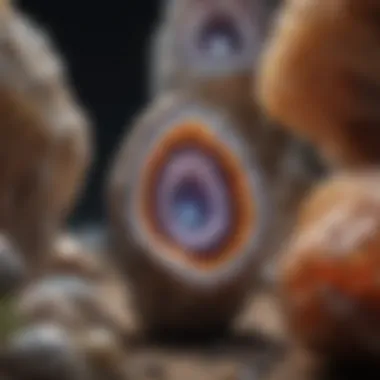
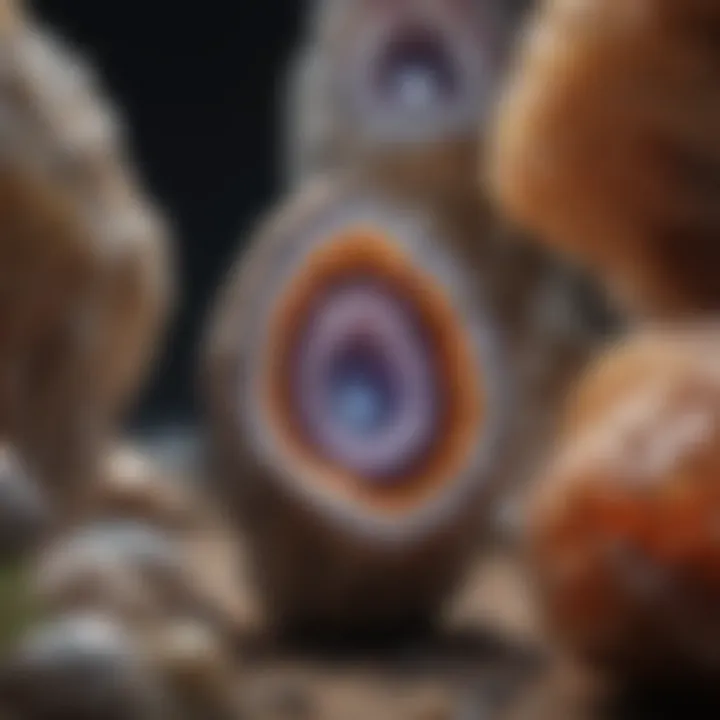
Educational Uses
Educational uses of geodes and agates extend beyond geology. They are often employed in school curricula to teach about crystallography, mineral formation, and natural history. Hands-on activities involving these stones engage students, fostering a deeper appreciation of Earth sciences.
Using geodes and agates in education invites curiosity and exploration. Practical demonstrations using these stones can make complex concepts more accessible. However, proper management is required to ensure safety when dealing with broken or sharp edges.
Healing Practices
The healing practices associated with stones like geodes and agates are also worth noting. Many believe that these stones hold metaphysical properties that can promote emotional healing and physical well-being. Individuals often carry or place crystals in their living areas to cultivate positive energy.
The distinctive attribute of healing practices lies in their personalized application—each stone is thought to resonate with different energies and intentions. However, skepticism exists surrounding these claims. While some may find peace and solace through these practices, others highlight the importance of seeking professional medical assistance when needed.
Care and Preservation Techniques
The dazzling allure of geodes and agates can easily overshadow the crucial aspects of their care and preservation. Understanding how to properly manage these geological wonders not only safeguards their beauty but also solidifies their longevity. This is particularly important for collectors who wish to maintain the integrity and value of their prized specimens. Techniques of care and preservation help avoid potential mishaps and ensure these minerals continue to captivate future generations.
Proper Storage Methods
Temperature Control
Maintaining an optimal temperature is a vital aspect of preserving geodes and agates. Extreme temperatures can result in fractures or discoloration, diminishing the aesthetic and market value of these stones. Storing them in a cool, stable environment, avoiding places subject to sudden temperature fluctuations, showcases the importance of temperature control. This consideration makes it a popular choice among collectors seeking to minimize risks. The unique feature of controlled temperatures allows collectors to avoid aesthetic changes, though some may find it challenging to find an ideal storage location that meets these requirements consistently.
Moisture Management
Moisture levels in the environment play a significant role in the preservation of geodes and agates. High humidity can potentially lead to mold growth or mineral corrosion. On the flip side, too dry an atmosphere may result in cracking. Hence, practicing effective moisture management enables collectors to strike a balance, keeping their specimens safe and sound. A dehumidifier or silica gel packs are often seen as beneficial additions to storage conditions. However, it is essential to monitor moisture levels diligently, as failure to do so can negate all the good practices in place, leading to not-so-pleasant consequences.
Mineral Compatibility
When storing multiple specimens, mineral compatibility must not be overlooked. Some minerals may react adversely when kept together, leading to unintended damage. Understanding which minerals coexist peacefully can help avoid any unwanted chemical reactions. Using separate compartments or cases is a beneficial practice, preventing any mingling that might harm the integrity of your collection. This strategic approach might require some effort in organizing, but the pay-off of preserving each piece's unique characteristics is well worth the time invested.
Cleaning and Maintenance
Gentle Cleaning Techniques
Cleaning your geodes and agates is an art that requires a delicate touch. Gentle cleaning techniques involve using a soft brush or cloth, combined with lukewarm water, to remove dust and grime without scratching the surfaces. This method ensures that the unique features of each stone remain intact, which aligns with the overarching goal of preservation. However, collectors should steer clear of harsh chemicals that can etch or dull the gemstone, which can be a trade-off for keeping them sparkling clean.
Avoiding Damage
When it comes to maintenance, avoiding damage is the name of the game. Preventative measures such as avoiding direct sunlight can help maintain vibrancy and prevent fading. Also, it's wise to position your collection securely to prevent accidental drops or scratches. The key to this practice lies in remaining aware of potential hazards in your environment. Although it may feel cumbersome to always stay cautious, the hassle of replacing damaged pieces far outweighs the inconvenience.
Restoration Advice
In cases where damage does occur, having a grasp of restoration advice is invaluable. From simple techniques like polishing natural surfaces to more advanced methods, such as professional repairs, understanding the options available can aid in restoring a piece to its former glory. Collectors must balance the desire to repair with the potential risk of further damage. The awareness of such a nuanced area adds depth to a collector’s expertise, ensuring informed decisions when confronted with care challenges.
"Proper care is not merely a task but a commitment to preserving the natural wonders that fill the Earth's crust."
In sum, nurturing geodes and agates demands time and attention but instills a sense of pride and ownership within the collector's heart. By embracing effective care and preservation techniques, rock enthusiasts can ensure their treasured collections remain sources of fascination and joy for many years to come.
Collecting Strategies
Collecting geodes and agates can be an exciting and fulfilling hobby, but like any endeavor, having a strategy is key to success. This section aims to provide both beginner and advanced collectors with practical tactics and tips to enhance their collecting experience. Having a solid plan can help collectors avoid common pitfalls and make informed decisions, ultimately adding to their enjoyment and appreciation of these geological treasures.
Beginner's Guide to Collecting
Starting a collection can feel daunting, but knowing what to look for can simplify the process significantly.
What to Look For
When beginning your journey in collecting geodes, one must focus on several important aspects. First and foremost, many enthusiasts recommend looking for geodes that have unique exterior textures. This exterior can hint at a spectacular interior. A rough, bumpy texture might suggest that the geode could contain quartz or calcite crystals. In many cases, just the right geode can turn out to be a real showstopper once it's opened.
Geodes that have a more rounded and symmetrical shape often hold more significant amounts of crystals inside, making them a popular choice among collectors. However, a key characteristic of what to look for is that beauty can be found in imperfection too. A less-than-perfect geode may house stunning formations within. These unique features can elevate the value and interest of your collection, balancing aesthetics with a story that's all their own.
Budgeting for Collectibles
Having a budget is essential in the world of collecting, especially for novices who might get lost in the excitement. It’s easy to overspend on the first few pieces, but sticking to a budget keeps your collection grounded and manageable. A simple tip would be to allocate a specific amount each month to spend on your new acquisitions, whether they are online finds or local treasures.
Services like eBay and Etsy often have a wide range of items at various price points, allowing flexibility depending on your budget. Being mindful about your spending can also open doors to more meaningful pieces in the long run. However, keep in mind that while rare finds are often worth splurging on, they should align with your overall budget strategy to avoid financial strain.
Local Vs Online Purchases
Choosing between local shops and online platforms can be a challenging decision for collectors. On one hand, local shops often allow you to directly examine the piece before purchase. You might even connect with the sellers, who can provide historical context or background on your item that enriches its narrative.
Conversely, online shopping opens up a broader selection of geodes and agates that smaller local shops might not carry. Websites like eBay and Etsy feature numerous listings, and with a little patience, collectors can discover rare gems at bargain prices. However, a potential drawback lies in the inability to inspect the item firsthand. Securing quality assurance from the seller can become crucial in this scenario, so always read reviews and check ratings before committing.
Advanced Collecting Tactics
As collectors gain experience, they may wish to refine their methods to expand their collection.
Networking with Other Collectors
Connecting with fellow enthusiasts can greatly enhance your collecting journey. Networking with other collectors opens up avenues for sharing knowledge, experiences, and even trade opportunities. Establishing relationships often leads to a more profound understanding of geological characteristics and market trends, providing insights that can elevate the quality of your collection.
Forums on platforms like Reddit allow collectors to share both questions and answers, enhancing the collecting experience for everyone involved. Attending local meet-ups or joining social media groups, such as those on Facebook, can also lead to finding mentorship within the community. The unique advantage here lies in the opportunity to trade or purchase from other enthusiasts while gaining valuable insights about the collection.
Attending Gem Shows
One of the most beneficial activities for serious collectors is attending gem shows. These events often feature a wide variety of geodes, agates, and more, making it the perfect setting for finding unique pieces. Additionally, they provide an excellent opportunity to learn about geological forms directly from vendors and experts, which can significantly enhance one’s understanding and appreciation.
However, a unique feature of gem shows is that the variety can lead to overwhelming choices. Having a plan before going can help you stay focused on what you're looking to add. The social aspect of interacting with other collectors also turns these shows into a community-building experience that can be immensely enjoyable.
Identifying Authenticity
As collecting evolves, so too does the necessity to discern authentic pieces from fakes or misrepresented agates and geodes. Awareness of geological identifiers is critical in ensuring that collectors don’t fall victim to scams. Enlisting the help of an appraiser or relying on trusted sources who understand the nuances of geodes and agates can be invaluable.
Certain characteristics, such as layering of minerals or the presence of unique colors, can hint at authenticity. Investing in a good loupe may help collectors closely examine their pieces to identify these features. The unique advantage of mastering authenticity checks means galvanizing confidence in your collection and promoting its value within the geological community.
Ultimately, collecting geodes and agates is a journey filled with learning, appreciation, and friendship. With the right strategies, collectors can uncover treasures that will enrich their collection for years to come.
Ending
In the realm of geology, the exploration of geodes and agates stands as a testament to nature’s incredible artistry and complexity. Understanding these geological wonders is not merely a delight reserved for hobbyists, but a significant pursuit that enriches our knowledge about Earth’s historical narrative and the processes that shape our planet.
Recap of Key Insights
To encapsulate the vast knowledge shared in this article, we can highlight several crucial takeaways about geodes and agates:
- Formation Processes: Both geodes and agates undergo intricate formation processes influenced by factors like volcanic activity, hydrothermal environments, and the specific minerals present in their surroundings. Recognizing these methods helps collectors appreciate the natural history embedded in each specimen, from quartz to calcite.
- Variety and Diversity: The robust variability among geodes and agates—ranging from strikingly beautiful amethyst geodes to the rare blue lace agate—illustrates not only nature's creativity but also the personal journey of every collector. Each type carries a unique story, revealing much about the localized geological conditions where they were formed.
- Uses and Applications: Beyond being stunning display pieces, geodes and agates have entered realms of art and science, serving purposes in jewelry making, educational demonstrations, and even alternative healing practices. This broad spectrum of applications validates their importance in various fields.
"Appreciating the beauty and story behind each piece transforms collecting from a simple hobby into an enlightening journey through geological time."
Encouragement for Collectors
For both novice and seasoned collectors, diving into the world of geodes and agates is an adventure ripe with potential for discovery. Here are a few points to keep in mind:
- Stay Curious: Every trip to a new dig site or gem show opens avenues for learning. Don’t hesitate to engage with fellow collectors or experts. Their insights can be invaluable, shedding light on the techniques and nuances associated with specific types.
- Invest in Knowledge: As much as physical collection matters, acquiring knowledge about geodes and agates is equally crucial. Read literature, join online forums, or participate in local geology clubs. The more informed you become, the deeper your appreciation will be for your collection.
- Practice Responsible Collecting: As you venture into collecting, always respect local laws and regulations regarding natural resource collection. Contributing to sustainable practices not only preserves geological sites but ensures that future generations can enjoy these treasures too.



